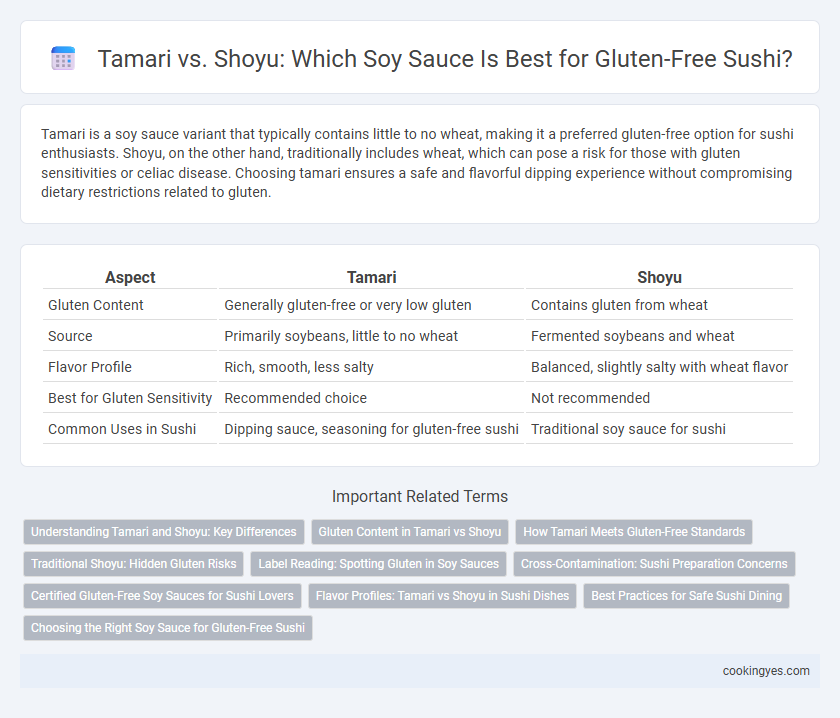Tamari is a soy sauce variant that typically contains little to no wheat, making it a preferred gluten-free option for sushi enthusiasts. Shoyu, on the other hand, traditionally includes wheat, which can pose a risk for those with gluten sensitivities or celiac disease. Choosing tamari ensures a safe and flavorful dipping experience without compromising dietary restrictions related to gluten.
Table of Comparison
| Aspect | Tamari | Shoyu |
|---|---|---|
| Gluten Content | Generally gluten-free or very low gluten | Contains gluten from wheat |
| Source | Primarily soybeans, little to no wheat | Fermented soybeans and wheat |
| Flavor Profile | Rich, smooth, less salty | Balanced, slightly salty with wheat flavor |
| Best for Gluten Sensitivity | Recommended choice | Not recommended |
| Common Uses in Sushi | Dipping sauce, seasoning for gluten-free sushi | Traditional soy sauce for sushi |
Understanding Tamari and Shoyu: Key Differences
Tamari is a gluten-free soy sauce alternative made primarily from fermented soybeans, often preferred by those with gluten sensitivities or celiac disease. Shoyu, a traditional Japanese soy sauce, typically contains a mixture of soybeans and wheat, making it unsuitable for gluten-free diets. Understanding these differences helps sushi lovers choose the right condiment that aligns with their dietary needs while preserving authentic flavors.
Gluten Content in Tamari vs Shoyu
Tamari typically contains little to no wheat, making it a popular gluten-free alternative to regular soy sauce (shoyu), which usually includes wheat and has higher gluten content. Tamari's fermentation process involves mainly soybeans, resulting in a richer flavor and lower gluten levels compared to shoyu. For individuals with gluten sensitivity or celiac disease, tamari offers a safer option while maintaining authentic sushi taste.
How Tamari Meets Gluten-Free Standards
Tamari is a Japanese soy sauce variant traditionally brewed without wheat, making it a reliable gluten-free option suitable for sushi lovers with gluten sensitivities. Unlike conventional shoyu, which often contains wheat and poses gluten risks, tamari undergoes a fermentation process that excludes gluten-containing ingredients. This distinction allows tamari to meet rigorous gluten-free standards, providing a safe and flavorful condiment alternative in sushi preparation and dining.
Traditional Shoyu: Hidden Gluten Risks
Traditional Shoyu, a staple soy sauce in sushi cuisine, often contains wheat, posing hidden gluten risks for individuals with gluten sensitivity or celiac disease. Tamari, on the other hand, is typically brewed with little to no wheat, making it a safer, gluten-friendly alternative. Careful label examination is essential for those avoiding gluten to ensure a safe sushi experience.
Label Reading: Spotting Gluten in Soy Sauces
When selecting soy sauce for sushi with gluten concerns, reading labels is crucial to differentiate between tamari and shoyu. Tamari is traditionally wheat-free, making it a safer choice for gluten-sensitive individuals, while shoyu often contains wheat, posing a potential risk. Always check for certifications like "gluten-free" or ingredients listing wheat to ensure safe consumption.
Cross-Contamination: Sushi Preparation Concerns
Tamari soy sauce is often preferred in sushi preparation for those with gluten sensitivities because it is traditionally brewed without wheat, reducing the risk of gluten exposure. Shoyu, on the other hand, typically contains wheat, increasing the chance of cross-contamination during sushi assembly when utensils or containers are shared. Sushi chefs must ensure separate handling and labeling to prevent gluten cross-contact, safeguarding individuals with gluten intolerance or celiac disease.
Certified Gluten-Free Soy Sauces for Sushi Lovers
Certified gluten-free soy sauces such as tamari offer sushi lovers a safe alternative to traditional shoyu, which often contains wheat and poses gluten risks. Tamari, primarily made from fermented soybeans without wheat, provides rich umami flavor while accommodating gluten sensitivities. Selecting tamari labeled as certified gluten-free ensures compliance with strict testing standards, enhancing both safety and authentic taste for sushi enthusiasts.
Flavor Profiles: Tamari vs Shoyu in Sushi Dishes
Tamari offers a richer, smoother flavor with less salt and a deep umami profile, making it ideal for enhancing the delicate taste of sushi without overpowering it. Shoyu provides a lighter, tangier soy sauce experience with a balanced saltiness, often preferred for dipping and adding subtle complexity to sushi rolls. For gluten-sensitive individuals, tamari is typically a better choice, as it is traditionally made without wheat, unlike most shoyu varieties that contain gluten.
Best Practices for Safe Sushi Dining
Tamari is a gluten-free soy sauce alternative commonly preferred for safe sushi dining by individuals with gluten sensitivities, whereas traditional shoyu contains wheat and poses a risk for gluten exposure. Restaurants should clearly label tamari on menus and use dedicated condiments to prevent cross-contamination, ensuring a safe experience for gluten-intolerant patrons. Proper staff training on gluten allergies and ingredient sourcing from certified gluten-free suppliers enhances best practices in sushi establishments.
Choosing the Right Soy Sauce for Gluten-Free Sushi
Tamari soy sauce is a gluten-free alternative to traditional shoyu, made primarily from fermented soybeans with little to no wheat, making it ideal for those with gluten sensitivities. Choosing tamari ensures sushi dishes remain safe for gluten-free diets without compromising the savory umami flavor essential to authentic Japanese cuisine. Always verify labels, as some shoyu contains wheat, posing a risk for gluten intolerance or celiac disease patients.
Tamari vs Shoyu for gluten concerns Infographic

 cookingyes.com
cookingyes.com